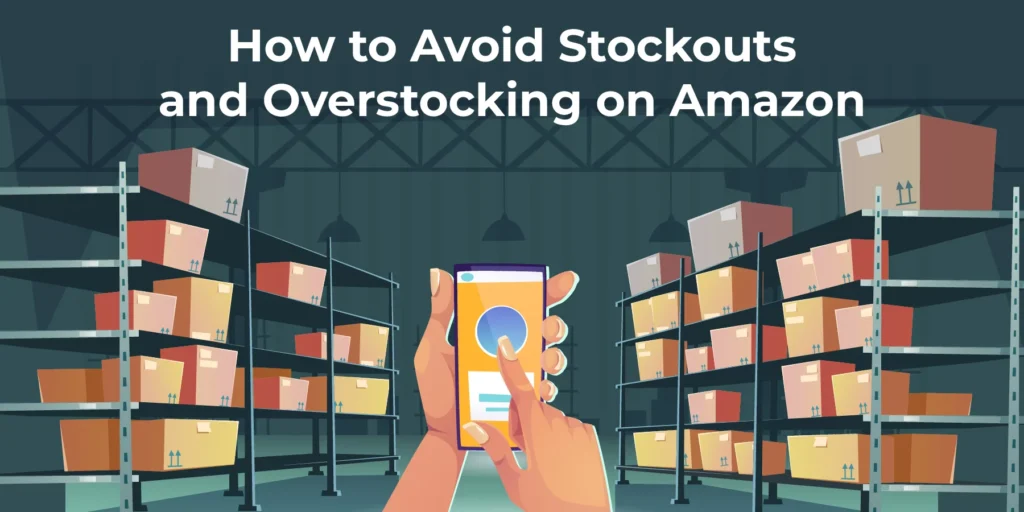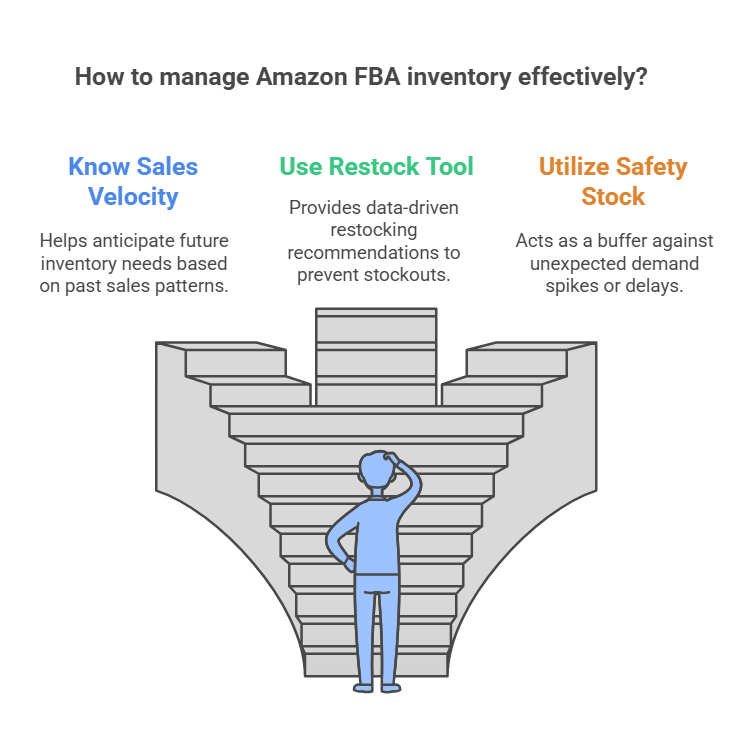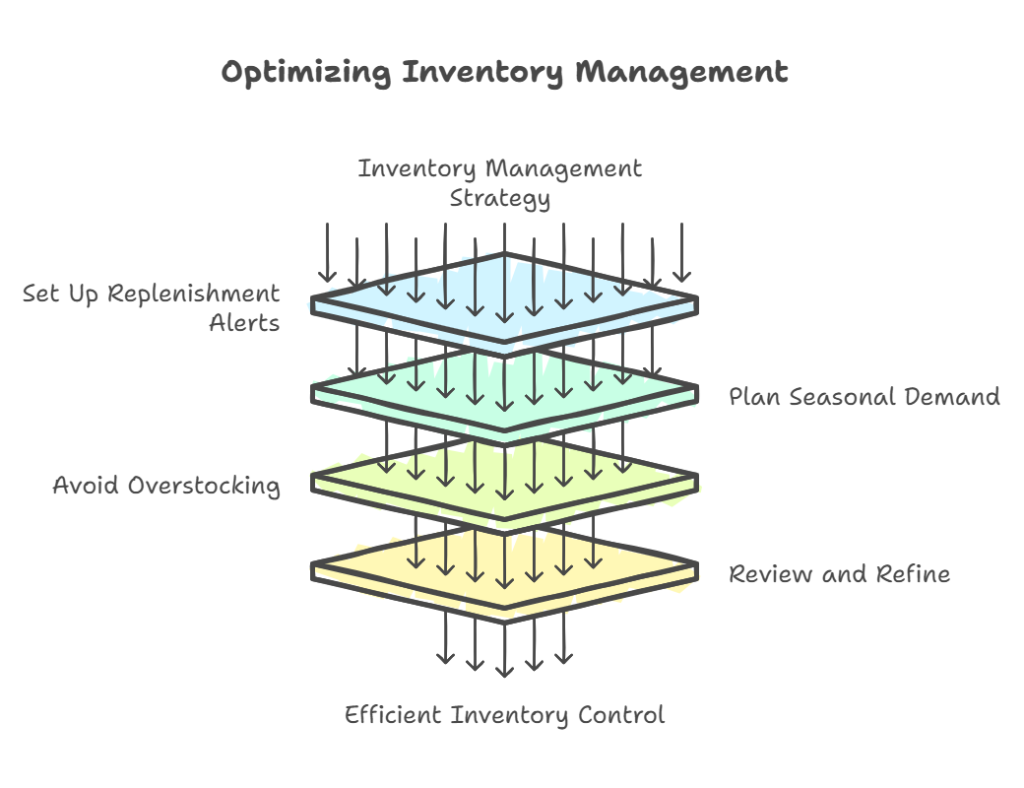Article
Amazon FBA Restocking Strategies: Avoiding Stockouts & Overstocks

Share
Amazon FBA Restocking Strategies: Avoiding Stockouts & Overstocks
Being an Amazon seller, keeping your inventory in check is perhaps the most important part of running a successful venture. Effective stock management is crucial to having a consistent stream of sales and ensuring your products are on hand when customers require them. One of the most important elements of this process is restocking your Amazon FBA (Fulfillment by Amazon) inventory efficiently. But achieving the balance between stockouts and overstocks is not easy. Stockouts may cause lost sales and damage your product rankings, whereas overstocks may cause additional storage charges and overinvested capital.
In this blog, we will discuss important restocking strategies that can assist you in avoiding stockouts and overstocks while maximizing your Amazon FBA business.
Know Your Sales Velocity
Sales velocity is how quickly your products are selling within a defined time frame. The richer you are in sales velocity knowledge, the simpler it will be to anticipate inventory you’ll require for upcoming months.
Actionable Tips:
Review historical sales: Amazon’s Seller Central reports past sales patterns. You can use them to project future demand.
Track seasonal fluctuations: If your product experiences seasonal spikes (e.g., around holidays), plan your inventory accordingly.
Factor in new product launches or promotions: If you’re running a promotion, your sales velocity may increase temporarily. Factor that in when estimating restocking needs.
Use Amazon's Restock Inventory Tool
Amazon also has a priceless tool known as the Restock Inventory Tool that gives you a snapshot of what you have in stock and helps you determine how much to reorder based on your velocity of sales. This will assist you in preventing stockouts, particularly if you do not know when to order the next batch.
Actionable Tips:
Use the “Days of Cover” measure: The software informs you of the number of days of inventory you have left. Target 30–45 days of cover, depending on your sales velocity.
Check suggested quantities on a regular basis: Amazon might indicate restock quantities based on your past sales. Tune these suggestions accordingly.
Take advantage of Safety Stock
Safety stock is additional inventory you hold in reserve as a buffer against surprise demand spikes or shipping delays. The level of safety stock you require varies with product type, supplier lead time, and supply chain reliability.
Actionable Tips:
Calculate your lead time: Figure out how long it takes for your supplier to get products into Amazon’s warehouses. Add a few extra days to include unexpected delays.
Maintain safety stock on high-demand products: High-demand items or those that take a long time from the supplier should have higher safety stock levels.
Track Inventory Health Metrics
Amazon provides several metrics related to inventory health, including the In-Stock Rate, Sell-Through Rate, and Restock Inventory recommendations. Keeping these metrics in check is crucial for ensuring your inventory stays balanced.
Actionable Tips:
Monitor your In-Stock Rate: Aim for a high in-stock rate (over 90%) to avoid stockouts.
Watch the Sell-Through Rate: This metric shows how quickly your inventory is moving. A high sell-through rate indicates strong demand, while a low rate could suggest that your product isn’t moving as expected.
Pay attention to your Restock Inventory suggestions in Seller Central to adjust your replenishment schedule accordingly.
Optimize Your Supply Chain
One of the best ways to prevent stockouts and overstocks is to optimize your supply chain and use trustworthy suppliers. Production or shipping delays can cause stockouts, while inventory with a slow sell-through rate can create excess.
Actionable Tips:
Build strong relationships with your suppliers: Make sure they know what your lead time needs are and can fulfill your forecasted demand.
Diversify suppliers: Multiple suppliers can help decrease the risk of disruption. If one of them is delayed, you have alternatives.
Automate ordering: Employ software applications or services that automatically order products according to stock level and sales pace.

Set Up Replenishment Alerts
Utilizing replenishment reminders is an excellent method to make sure you never miss a restocking opportunity. Amazon and third-party software enable you to automate reminders for when your inventory is low or when it’s time to reorder.
Actionable Tips:
Create reminders for key products: Determine products that generate most of your revenue and make sure they are always available.
Adjust reminders seasonally: In case your product is seasonal, send reminders for restocking quite early before the peak seasons.
Plan Seasonal Demand
Some products have seasonal variation in demand as a function of the time of year, such as surges around holidays or events. Having a plan to anticipate these seasonality trends can help prevent stockouts at the peak periods and overstocks when business is off-peak.
Actionable Tips:
Based on past records, make seasonal demand forecasts during peak periods.
Stock up well in advance of holidays or sale events to prevent stockouts.
Review competitors’ sales cycles to identify industry-wide seasonal fluctuations.
Don't Overstock with Intelligent Replenishment
Although it is essential to prevent stockouts, ordering excessive inventory may result in overstocks and further storage charges, particularly with Amazon FBA’s long-term storage fee regulations. Maintaining an equilibrium of your inventory with demand is important in maximizing profit and preventing unnecessary expense.
Actionable Tips:
Implement just-in-time inventory methods: Replenish stock only when necessary and in smaller units to avoid the risk of overstocks.
Run regular inventory checks: Check your stock levels on a regular basis to make sure you’re not carrying too much inventory.
Watch Amazon’s long-term storage charges: Amazon is more expensive to store inventory beyond 365 days, so keep slow-moving stock from lingering in storage.
Review and Refine on a Regular Basis
Your restocking plan must never remain fixed. The secret to successful inventory management on Amazon FBA is constant monitoring and adaptation according to sales patterns, market trends, and your business objectives.
Actionable Tips:
Monitor your inventory turnover: Monitor how fast your inventory is moving and restock accordingly.
Review your sales projections: Utilize data from your past months and seasons to project demand more accurately.
Test new tactics: Experiment endlessly with alternative strategies for restocking, such as changing order levels and modifying lead times.

Conclusion
Good Amazon FBA restocking strategies are necessary to keep your business on a smooth run and ensure you never lose out on sales or overstock and end up paying unnecessary charges. Understanding your velocity of sales, employing tools such as Amazon’s Restock Inventory Tool, and streamlining your supply chain, you can find the right balance between stockout and overstock.
Don’t forget that inventory management is an ongoing process. By tracking your sales, revising your forecasts, and remaining proactive with your supply chain, you can sidestep costly errors and make sure your Amazon venture prospers.